
Hiking Tips
Ridiculed by some hikers but appreciated and even revered by most, walking poles are essential to a hiker’s toolkit. In this post, you’ll learn how to use walking poles correctly, how to choose them and how to set them up
What Are Walking Poles?
First things first, what exactly are walking poles? The term is self-explanatory: walking poles are a pair of poles (or sticks) used while walking or hiking. They’re sometimes also called hiking poles or trekking poles.
Most hikers use two poles for maximum balance, but some swear by a so-called walking staff, also known as a travel staff. This can be anything from a solid tree branch to adjustable shock-absorbing staffs. Walking staffs are typically used on flat terrain while not carrying heavy backpacks.
Hiking poles are much more common, though, so we’ll focus on those in the rest of this blog post.
Why Use Walking Poles for Hiking?
Okay, now you know what walking poles are, let’s talk about why you might want to use them. What are the benefits of using walking poles anyway?
Well, it turns out there are many benefits of walking poles. From improving your posture and stability to decreasing the load on your back, using walking poles while hiking is almost always a good idea.
The Mayo Clinic, always a good resource for health-related questions, lists the following benefits of using walking poles:
- Arm movements associated with walking poles make your aerobic workout more intense. There’s more movement, so you burn more calories.
- Walking poles improve your stability and balance while hiking. This is especially beneficial when hiking on rough terrain.
- Walking poles help maintain proper posture, particularly in the upper back area. Using them properly could make your upper back muscles stronger.
- Using walking poles may also improve your mood, which is always good!
Any experienced hiker who has used poles before will be able to add several other benefits to that list. Off the top of my head, I often use hiking poles for these additional reasons:
- They offer extra support and protect your knees when hiking downhill.
- Walking poles can significantly increase your speed and endurance when hiking uphill. I like to compare them to using handrails on stairs. You use those to push yourself up, and the same principle applies to using walking poles when hiking uphill.
Considering all these fantastic benefits, it’s surprising that not all hikers use walking poles. I know some people are sceptical about them, though. I was one of the sceptics, too, but once I tried a pair on a hike, I was completely sold. Now, I bring my walking poles on virtually every hike.
If you’re still wondering, “Do walking poles help?” let me assure you that they do!
Okay, let’s now move on to the main topic of this blog post: how to use your walking poles properly.
How to Use Walking Poles Correctly
Let’s break down the proper use of walking poles into three main categories. First, knowing how to choose your walking poles is essential—what you should pay attention to. Second, we’ll look into how to set up your poles. Lastly, we’ll discuss the best ways to use your walking poles on the trail.
How to Choose Walking Poles
There are dozens, if not hundreds, of different walking poles on the market today. Navigating this vast offer can be daunting but easier than you might think. You need to consider a few things when choosing the best walking poles for you.
1. Single or a pair?
Do you want a single hiking staff or a pair of hiking poles? I recommend getting a pair of poles, which this post is about.
2. What is the correct length?
You can use a simple rule of thumb to determine the correct height for walking poles. When holding the handgrip and the pole’s tip touches the ground, your elbow should be at a 90-degree angle. That’s it!
This is something that only really applies when you’re getting non-adjustable walking poles or a solid staff. Most walking poles nowadays are adjustable.
3. Which features do you want?
What are you going to use the poles for? Are you just going for summer hikes or snowshoeing in winter?
Consider foldability, shock absorption, different locking mechanisms for adjustable poles, weight, straps or no straps, and the price. Some hiking poles have snow baskets, making them ideal for winter outings.
How to Set Up Walking Poles
Once you’ve found your ideal pair of hiking poles, you should know how to set them up correctly. There are only two things to know, which are pretty simple.
Adjusting and Using the Wrist Strap
Some walking poles don’t have straps, but I highly recommend getting a pair that does. Wrist straps allow you to hike with a looser grip, which is much more relaxing. They also allow you to push down on them when walking uphill, propelling you forward more.
“Thinking of getting into hiking? Find out about the incredible benefits that await you”
To determine the proper length of your wrist straps, put your hands through the bottom, pull down and grab the hand grips. The straps should be over the back of your hand, not twisted and with your thumbs over the straps.
You should be able to feel whether or not it’s too loose or tight. When you’ve figured out the correct strap length, the poles will be an extension of your arms, yet with enough space. You can let them hang freely and sway the poles back and forth.
Adjusting the Length of Your Poles
I’ve already mentioned the 90-degree elbow angle above, which is your go-to method to properly adjust the length of your walking poles.
This can easily be converted into a helpful table, which connects your height to your ideal walking pole length. You can use this sizing chart.
In general, it’s straightforward to figure out the best walking pole length for you. The formula is your height in centimetres multiplied by 0.68. The resulting number is the length of your walking poles in centimetres.
If you don’t have a calculator, you can use the 90-degree method, which works just as well.
How to Use Walking Poles on the Trail
Finally, let’s look at the best ways to use walking poles on the trail. This is, after all, why you got your poles in the first place!
Using Walking Poles Efficiently
There are a few techniques you should learn and apply while hiking. Using these, you’ll get the most out of your hiking poles.
Gripping Your Poles
If you’ve set up your wrist straps correctly, the pole should be able to rotate between your index finger and thumb while your hand is relaxed. With that relaxed grip, you can flick the pole forward with each step and pull yourself forward by pulling down the strap.
You only need your index finger and thumb for a relaxed grip while hiking. You can loosely close your other fingers but not squeeze the grip too tightly. This will only exhaust your hands and wrists.
Alternating Your Legs and Poles
With a nice, loose grip, the poles can be flicked forward. Getting this right is essential, but luckily not too difficult to figure out.
The next step—both figuratively and literally—is when to flick which pole forward. Imagine walking naturally without holding anything in your hands (you can even stand up and walk around the room).
You’ll notice that the opposite arm will sway forward when you place one foot forward, too. This is how your body keeps itself in balance while you walk.
“Want to get in shape before you hit the trails? Find out how…”
This is also the ideal pattern to follow when hiking with poles. So, when you place your right foot forward, your left arm and walking pole should also go forward—and vice versa.
It might feel awkward initially, but remember that this is your natural way of walking. Don’t overthink it; just be aware of this and correct yourself if you notice you’re doing it wrong.
Planting Your Poles
You don’t have to thrust your poles into the ground for them to help you. Simply planting them lightly on the ground is enough to provide more stability and balance. If you’re hiking on flat terrain, the poles will only briefly touch the ground before you flick them forward again.
Walking Downhill
You may want to extend your poles more when hiking down a slope. They’ll need more length to reach the ground since they’ll be in front of you when you walk down. Usually, extending them 5-10 more centimetres should do the trick.
They will also offer extra balance points and absorb some of your (and your backpack’s) weight, which takes some of the load off your knees.
Walking Uphill
Shortening your poles a little on steep uphill sections of your hike is a good idea. Again, shortening them by 5-10 centimetres should be enough. The steeper the slope, however, the shorter your poles should be. This is a bit of trial and error—you’ll experience the ideal length.
Ideally, you can use your poles for extra propulsion power when hiking uphill. Place them close to your feet and not in front of them. The key is the push yourself up rather than pull.
Sometimes when hiking either downhill or uphill, it’s worth abandoning the alternating-foot-and-arm technique for a while. In certain situations, using both walking poles together is more beneficial, whether offering support when descending steep slopes or pushing you up on sharp inclines.
How to Use Walking Poles Video
Conclusion
You now know how to use walking poles correctly, what to look for when buying them and how to set them up properly. If you don’t yet have or use trekking poles, you may want to try them at least. Like me, you’ll quickly realize their tremendous benefits and probably become a huge fan!
Like Our Article? Please Pin it!


Good video & demo of pole use on different terrain. I’m forwarding it to a friend who walks a lot and who wants to add more upper body strength to her workouts. I haven’t used poles much for walking, but I’m going to practice.
I sure wish adjustable poles were around when I backpacked the Sierra Nevada in California!
In the VIDEO, it looks as though there were a twist in the strap before the two ends join. From years of cross country skiing (in the past) I always thought the top side of the strap goes toward the thumb and the bottom side goes toward the pinkie. Am I wrong?
What is the brand of those straps in the PHOTO! Wow!
Hi Leslie,
Thanks for your comment. The actual video on our page that you liked and shared is actually a third-party video but one we particularly liked and felt was a good fit for our content. What’s more, this guy uses his poles in exactly the same way that we do and explains how to use them so well. If you watch his video here: https://www.youtube.com/watch?v=7q2YwOE4okA&t=190s you can drop any queries that you have into the comment box below the video. In reference to the straps in the photo, I can’t tell you exactly what brand these are but these types of straps are known as Nordic walking gauntlets. This is an example of something similar that I spotted online: https://www.decathlon.co.uk/p/pw-g900-nordic-walking-gauntlets-black/_/R-p-303928
Hope this helps and happy hiking!
Gavin